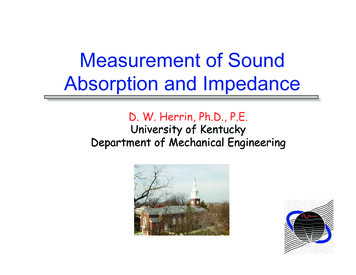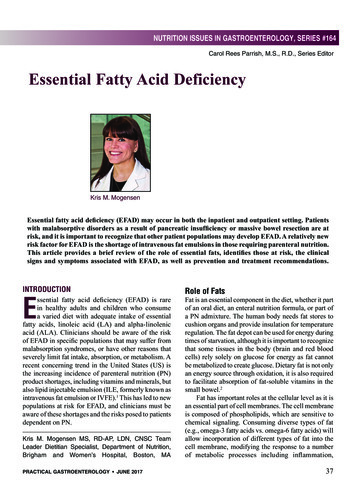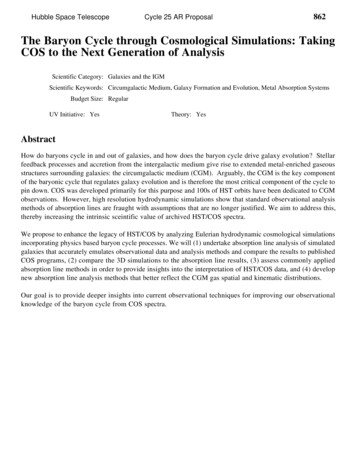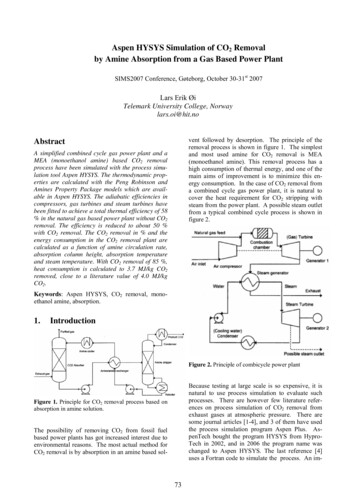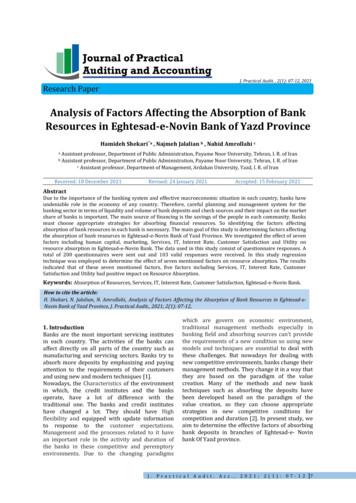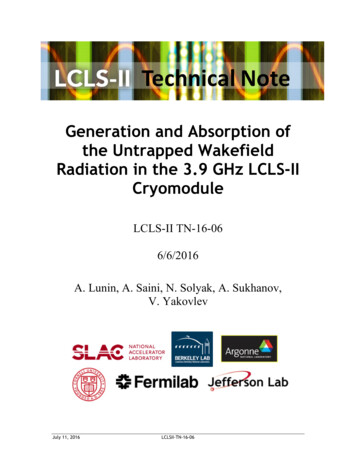
Transcription
Generation and Absorption ofthe Untrapped WakefieldRadiation in the 3.9 GHz LCLS-IICryomoduleLCLS-II TN-16-066/6/2016A. Lunin, A. Saini, N. Solyak, A. Sukhanov,V. YakovlevJuly 11, 2016LCLSII-TN-16-06
L C L S - I IT E C H N I C A LN O T E1 ABSTRACTConstruction of the Linac Coherent Light Source II (LCLS-II) is underway for the world’s first hard Xray free-electron laser. A central part of the LCLS-II project is a 4 GeV superconducting radio frequency(SCRF) electron linac that will operate in continuous wave (CW) mode. The linac is segmented into foursections named as L0, L1, L2 and L3. The 3.9 GHz third harmonic cavities will be used in the section L1 ofthe linac for linearizing the longitudinal beam profile [1]. Cavities are primary sources of a beam excitationof broadband wakefield, which cannot be extracted effectively using higher order mode couplers, andtherefore, most of the associated power is deposited to cryomodules and beam line components. Evaluationof power deposition by untrapped radiation is critical for determination of the overall cryogenic heat loadand preventing an overheating of beam line components. In this paper, we present numerical and analyticalevaluations of wakefield electromagnetic spectrum in the 3.9 GHz cryomodule. Furthermore, a detailedanalysis is performed in order to estimate power depositions in the third harmonic section of the LCLS-IIlinac using diffusion and transition models.2 INTRODUCTIONA continuous wave operation regime of the 3.9 GHz LCSL-II accelerating structure at maximum averagebeam current of 0.3 mA and 1 MHz bunch repetition rate is resulted in about ten watts of uncoherent RFlosses in the form of untrapped high-order-modes (HOM) propagating along the beam line. Theelectromagnetic spectrum of wakefield is limited by the length of a single bunch, which is 1 mm rms in theL1 section of the linac. Therefore, the bandwidth of wakefield, carried over 99% of total radiated power, isabout 100 GHz in the L1 section comparing to 1 THz broadband wakefield in the L3 section, where the bunchlength is 25 µm [2]. Comparison of electromagnetic spectrums of two wakefields is presented in Figure 1.We discuss the details of wakefield electromagnetic spectrum simulations in the section 3 bellow.11.3 GHz CM3.9 GHz CMdP/df, [W/GHz]0.10.010.0010.00011101001000Freq., [GHz]Figure 1 Spectrum of electromagnetic power of wakefields in 3.9 GHz (red) and 1.3 GHz (blue)cryomodules of L1 and L3 linac sections respectively.A thorough analysis of wakefield power deposition in the 1.3 GHz LCLS-II cryomodule is presentedfirst in [3], where most of the power ( 80%) is predicted to be absorbed in the special ceramic absorberinstalled between cryomodules. This initial estimation is based on the diffusion model of a photon gas and itdoes not count radiation losses. Later the model was improved by adding auxiliary beam line componentsand a semi-analytical approach of a wakefield radiation to fundamental and high-order-modes couplers, butthe overall balance of power depositions has a minor change [4]. In a contrary, the wakefield in the 3.9 GHzcavity has a denser low frequencies spectrum and propagates in the beam line with smaller aperture. Hence,we may expect larger couplings of propagating HOMs with external ports of the cryomodule. For an accuratecalculation of wakefield heat loads in the 3.9 GHz cryomodule, we introduce two new methods: a) wakefielddecomposition and b) equivalent surface impedances. The method of decomposition is based on wakefieldexpansion into propagating modes in the circular beam pipe, where to the initial approximation we count thatall modes are monopole only. Consequently, in the transition model we use direct numerical calculations ofmultimode s-matrixes for an estimation of the wakefield power absorption (radiation) in individual beam lineJuly 11, 2016LCLSII-TN-16-062
L C L S - I IT E C H N I C A LN O T Ecomponents. The method of equivalent surface impedances comes straightforward as the result of wakefielddecomposition and implies a substitution of the individual component by a section of circular pipe with anequivalent surface impedance providing the same single pass wakefield power loss. We apply then equivalentimpedances for simulation of heat loads balance using the diffusion model.3 WAKEFIELD ELECTROMAGNETIC SPECTRUM SIMULATIONS.For an axially symmetric structure and a bunch with charge q(s) moving along the axis theelectromagnetic power spectral density of a wakefield is defined as a convolution of the longitudinalimpedance with the bunch density [5]:(1) where q0 is the bunch charge, fb is the bunch repetition rate, Zǁ is the cryomodule impedance and σz is thebunch rms length. The longitudinal impedance is determined as a Fourier harmonic of the point wakefunction: (2) For the first time simulations of wake fields in the third harmonic section of the TTF-II facility ispresented in [6], where authors describe the analytical expression of the wake function by fitting it withnumerically obtained wake potential. We follow to a similar procedure for finding wake function of the 3.9GHz LCLS-II cryomodule. The detailed layout of the cryomodule is shown in Figure 2. Each cryomodulecontains eight cavities, nine bellows with flanges and two gate valves. There is a transition section withincreased 78 mm aperture between cryomodules, where the beam line absorber (BLA) is installed. The resultsof loss-factor calculations using ECHO 2D program are summarized in the Table 1 [7].Table 1 Loss-factors of the 3.9 GHz cryomodule and sub-componentsInput geometryLoss-factor, [V/pC]Cavities only113.9Cavities and bellows135.5Full 3.9 GHz CM151.6Figure 2 Beam line layout of the 3.9 GHz cryomodule for the LCLS-II linacBased on ECHO results we derived analytical approximation for the point longitudinal wake function: July 11, 2016/0.9. LCLSII-TN-16-06, [V/pC](3)3
L C L S - I IT E C H N I C A LN O T Ewhere H(s) and δ(s) are Heaviside step function and Dirac delta function, s0 8.4*10-4, A 784, B 1098.Comparison of wake functions of 1.3 GHz and 3.9 GHz cryomodules are illustrated in Figure 3. Numericalcoefficients in the formula (3) are chosen for best fit with the ECHO wake potential simulation.0-200W0, [V/pC]-400-600-8001.3 GHz CM3.9 GHz CM-1000-1200-1012345678910s, [mm]Figure 3 Longitudinal wake function of a point like charge in 1.3 GHz (blue) and 3.9 GHz (red)cryomodulesFor a single bunch of charge Q passing through the cavity parallel to the axis, the wake potential is givenby the convolution of the wake function with the bunch density: (4) (5)The result of an approximation of the numerical (ECHO) wake potential in the 3.9 GHz cryomodule by theanalytical equation (4) is presented in Figure 4 for the Gaussian bunch of 1 mm rms length.0Wake Potential, [V/pC]-50-100-150-200AnalyticalECHO 2D-250-300-5-4-3-2-1012345s, [mm]Figure 4 Comparison of ECHO 2D (solid blue) and analytical (dotted red) wake potential in the3.9 GHz LCLS-II cryomoduleFinally, we obtain the steady state power density of the wakefield for an rms bunch length of 1 mm; abunch charge 300 pC and a 1 MHz bunch repetition rate (see Figure 1). Since we are interested in a study ofpower deposition by untrapped HOMs only, we excluded the part of the wakefield spectrum below the beampipe cut off frequency of the first propagating monopole mode. The integrated steady state wakefield powerJuly 11, 2016LCLSII-TN-16-064
L C L S - I IT E C H N I C A LN O T Eis presented in Figure 5 for 1.3 GHz and 3.9 GHz LCLS-II cryomodules. The overall powers of wakefieldsabove the TM01 mode cut off are estimated to be 12.8 W and 9.4 W respectively.10987P, [W]61.3 GHz CM3.9 GHz CM5432100102030405060708090100Freq., [GHz]Figure 5 Integrated steady state wakefield power generated by 25 µm bunch (blue) and 1 mm bunch(red) of 300 pC and 1 MHz, in the 1.3 GHz and 3.9 GHz LCLS-II cryomodules respectively.4 TRANSITION MODELThe wakefield transition model is based on the idea of a wakefield decomposition into propagatingmodes in the circular beam pipe, which is the analogue of Fourier basis [8]. Since the full-scale 3D analysisof a propagation of all circular waveguide modes is too complex and time consuming, we simplify theproblem by taking into account only monopole TM0n modes exited by a beam and neglecting furthertransformations to non-symmetrical modes. Besides, the TM0n modes are mixed by themselves during apropagation through the cryomodule. Numerical results of the ANSYS HFSS [9] analysis of monopole modestransmission through the 3.9 GHz cavity at high frequency range is presented in Figure 2S120.80.920302224262830Freq., [GHz]Freq., [GHz]Figure 6 Single pass transformation of TM01 (left) and TM02 (right) modes in the 3.9 GHz 9-cell cavityOne can see that a single monopole mode at the input is almost equally mixed up with others propagatingTM0n modes after a transmission through the cavity. Thus, as the initial approximation we can assume thatwakefield power is equally distributed among all propagating TM0n mode at the given frequency: (6)where N(ω) is the number of TM0n modes below the cut off at given frequency. The composition of theintegrated wakefield power in the 3.9 GHz cryomodule is shown in Figure 7 for the first three monopolemodes. Finally, we can estimate the single pass absorption of the wakefield power in the individual beamJuly 11, 2016LCLSII-TN-16-065
L C L S - I IT E C H N I C A LN O T Eline components: 1(7)where ωc01 is the cut off frequency of the first propagating TM01 mode, dPTM0n/dω is the TM0n mode powerdensity of the decomposed wakefield, S12 and S11 are transmission and reflection elements of scattering matrixof the TM0n mode at the given frequency.Figure 7 Monopole modes composition of the integrated wakefield power in the 3.9 GHz cryomoduleThe results of ANSYS HFSS driven modal simulations are presented in Figures 8 and 9 for monopolemodes transmission through the BLA and the fundamental power coupler (FPC). The FPC model includes aceramic window and a copper antenna. The BLA in LCLS-II cryomodules contains a hollow ring of the lossySTL-150D aluminum nitride ceramic by Sienna Technology [10, 11]. According to the vendor specification,the ceramic has a measured permittivity Re(ε)/ε0 30 and a loss tangent δ 0.4 in the frequency range of 5GHz to 12 GHz. As a conservative approach we take constant values of Re(ε)/ε0 30 and δ 0.4 for ceramicbroadband properties up to 100 GHz.Figure 8 Electrical field distribution for BLA (left) and FPC (right) components of the 3.9 GHzcryomodule with the TM01 mode excitation at 20 GHz 30.30.20.20.10.10.001020304050607080Freq., [GHz]010203040Freq., [GHz]Figure 9 Transmission of TM0n modes through the BLA (left) and FPC (right) beam line componentsJuly 11, 2016LCLSII-TN-16-066
L C L S - I IT E C H N I C A LN O T EWe performed similar calculations of scattering matrices for all beam line components in the thirdharmonic section of the LCLS-II linac, including radiations to gate valves, HOM couplers and to the upstreamwarm section of the beam pipe with reduced 32 mm aperture. Evidently each components is characterized bya maximal coefficient of a power absorption (radiation) of the TM0n signal near the cut off frequency and itfurther gradual decay toward the high frequency range. The final estimation of single pass wakefield powerlosses in individual beam line component is summarized in the Table 2.Table 2 Single pass wakefield power losses in beam line components of the 3.9 GHz sectionComponent1-pass loss, [%]BLAFPCGateValveHOMCBellows(Cu-plated)End Pipe(2.5 m, SS)End Pipe(Ø32 mm, rad.)42202.71.60.21141In our particular interest, we can calculate the amount of wakefield power radiated upstream anddownstream from the cryomodule. For a rough approximation, we assume that wakefields are radiatedsymmetrically by each cavity in the cryomodule and the cavity itself does not introduce any losses andreflections. Before the wakefield reaches the cryomodule exit, it propagates through the chain of cavities,couplers and bellows. Hence, the power radiated to each side by a single 3.9 GHz cryomodule is defined: 121.7(8)where P0 9.4 W is the total integrated wakefield power of the cryomodule and SPFPC, SPHOM, SPBELLOWS area single pass signal power loss in couplers and bellows. Taking into account multiple signal reflections fromcavities it is likely that the coupling with external ports is increased and, hence, less wakefield power will beradiated outside of the cryomodule.5. DIFFUSION MODELThe diffusion model was proposed for the estimation of an absorption of the wakefield generated byultra-short bunches in the 1.3 GHz XFEL cryomodule [3, 12]. There are two approaches used in the diffusionmodel: a) the wakefield energy is uniformly distributed and fully absorbed within the periodic section of thelinac and b) wakefield power deposition is proportional to the overall surface areas occupied by the beamline component and its surface impedance. While the diffusion model is a good approximation for thebroadband wakefield in the 1.3 GHz cryomodule, we have to use it carefully in the 3.9 GHz cryomodule,where an electromagnetic spectrum of the radiated wakefield is much narrower and a wakefield couplingwith external ports is large (see Table 2).1Wake SpectrumBLA LossFPC RadiationHOMC RadiationGV RadiationdP/df, q., [GHz]Figure 10 Spectrum of wakefield losses in beam line components of the 3.9 GHz cryomoduleAn important parameter of the diffusion model is the surface impedance. There is a straightforwarddefinition of a surface impedance for lossy conductors as the real part of the surface resistance:July 11, 2016LCLSII-TN-16-067
L C L S - I IT E C H N I C A LN O T E1(9)where σ is the material conductivity. In addition, we have to introduce the model of equivalent impedancesfor losses associated with power radiations or absorptions within beam line components for an adequate useof the diffusion mode. The idea is a substitution of a lossy element by the section of a beam pipe with anequivalent surface impedance and a length corresponding to the same amount of a power loss due towakefield propagation. Numerically calculated spectrums of wakefield losses in the beam line componentsof the 3.9 GHz cryomodule are illustrated in Figure 10. Following to the wakefield decomposition methoddescribed in (6), the single pass power loss of the nth monopole mode at given frequency is equal to:1(10)where l Srad/(2πrb) is the length of a section, Srad is the area of a lossy element occupied in the beam pipe,rb is the beam pipe radius and α is the attenuation constant. For monopole modes, the attenuation constant isdefined as:1(11)where Z(ω) is the equivalent impedance at given frequency and Z0 is the free space impedance. Finally, wecan sum up losses from each monopole mode and equal it to the result of a direct numerical simulation: (12)1000100Impedance, [ ]1010.1BLA (absorbtion)FPC (radiation)HOMC (radiation)GATE VALVE (radiation)STEELCOPPER (ASE&RRR15)0.010.0010102030405060708090100Freq., [GHz]Figure 11 Equivalent surface impedances (dotted) of beam line components and impedances of thestainless still 316L and copper materials.By solving the system of nonlinear equations (12), we can derive equivalent surface impedances for allbeam line components. The result is shown in Figure 11 with a comparison to impedances of the stainlesssteel 316L used for some components and the copper within assumptions of the anomalous skin effect (ASE)and a low value of the RRR 15 [13]. One can see that the equivalent impedance of the BLA is about twicelarger than the theoretical value for a lossy ceramic given in [3]. The difference is explained by the nature ofthe BLA design, where electromagnetic field penetrates into the hollow ceramic ring on both inner and outersides (see Figure 8), while the theoretical result takes only the inner ceramic surface into account.Table 3 List of beam line components in the 3rd harmonic section of the LCLS-II linacJuly 11, 2016LCLSII-TN-16-068
L C L S - I IT E C H N I C A LN O T EComponentBLAFPCGateValveHOMCBellows(Cu-plated)End Pipe(2.5 m, SS)Spool Pipe(1 m, Cu)#2(3)164321811Surface area, [mm2]1.4e47.1e22.0e23.1e23.7e46.2e51.0e5The list of beam line components and their surfaces are provided in the Table 3 as an input for thediffusion model analysis of wakefield power depositions in the 3rd harmonic section of the LCLS-II linac.6. WAKEFIELD POWER DEPOSITONS ANALYSISThe layout of the 3rd harmonic section of the LCLS-II linac is shown in Figure 12 for two consideringoptions: a) a single BLA is installed after the CM1 3.9 GHz cryomodule and b) two BLAs are installed afterboth CM1 and CM2 cryomodules. The left side BLA belongs to the preceding 1.3 GHz cryomodule, but weincluded it to our model since it absorbs a major part of the upstream wakefield radiation.Figure 12 Proposed layouts of the 3rd harmonic section of the LCLS-II linac with one (A) and two (B)beam line absorbers installed after 3.9 GHz cryomodulesFor a calculation of wakefield power deposition, we count only first two passes of the signal transmissionin the transition model and we neglect any signal radiation out of the 3rd harmonic section in the diffusionmodel. The results of a wakefield power deposition analysis are summarized in the Table 4.Table 4 Wakefield power depositions in the 3rd harmonic section of the LCLS-II linacWakefield Power Deposition, [W]ComponentTransition ModelDiffusion ModelABABBLA2.63.61012Bellows (Cu&SS)0.140.140.160.12Spool Pipe (Cu)0.010.010.010.01End Pipe Gate Valve0.60.551.41.1Downstream Radiation0.90.3--Upstream Radiation0.90.9--Total Power18.918.918.918.9Evidently, a significant amount of the wakefield power is radiated to FPC and HOMC ports. Accordingto the transition model over 65% of wakefield power is absorbed within the 3.9 GHz cryomodule itself.Installation of an additional BLA (variant B) looks impractical since it intercepts only 5% of the total power.For a conservative estimation, we assume that all radiated power is absorbed within beam line components.July 11, 2016LCLSII-TN-16-069
L C L S - I IT E C H N I C A LN O T EThe final list of cryogenic heat loads caused by a wakefield radiation in the 3rd harmonic section of the LCLSII linac is presented in Table 5 for the baseline variant A. Both models predict similar heat loads on 2K and50K cooling circuits, while the transition model estimates more accurately the radiation to HOM couplersresulting in about 1.8 W heat load to the 5K cryogenic line.Table 5 Cryogenic heat loads in the 3rd harmonic section of the LCLS-II linacCryogenic Heat Loads, [W]Wakefield RadiationModel2K5K50 KTransition0.141.816.1Diffusion0.160.817.97. CONCLUSIONSThe estimation of wakefield power deposition in the 3rd harmonic section of the LCLS-II linac iscompleted using two independent transition and diffusion models. Both models show a significant amountof radiated wakefields, up to 65%, going to FPC and HOMC ports of the 3.9 GHz cryomodule. Thus, themajor part of the total wakefield power (85%) is a source for the 50 K cryogenic heat load, while the rest isresulted in about 10% and 1% of the power deposition going to 5 K and 2 K circuits respectively.8. REFERENCES[1]SCRF 3.9 GHz Cryomodule Physics Requirements Document, LCLSII-4.1-PR-0097-R2, SLAC, 2016[2]K. Bane, et al., “Wakefields in the Superconducting RF Cavities of LCLS-II”, THPP124, LINAC’14,Geneva, Switzerland, 2014[3]K. Bane, et al., “Distribution of Heating from Untrapped HOM Radiation in the LCLS-IICryomodules”, Physics Procedia, Volume 79, Pages 13-20 (2015)[4]Cryogenic Heat Load, LCLS-II Engineering Note, LCLSII-4.5-EN-0179-R2, SLAC, 2015[5]S. A. Heifets and S. A. Kheifets, “Coupling impedance in modern accelerators”, Reviews of ModernPhysics, Vol. 63, No. 3, July 1991[6]I. Zagorodnov, T. Weiland, “Wake Fields Generated by the LOLA-IV Structure and the 3rd HarmonicSection in TTF-II”, TESLA Report 2004-01[7]I. Zagorodnov, T. Weiland. 2005. PRST-AB 8, 042001[8]J.A. Stratton, Electromagnetic Theory, McGraw-Hill, NY, NSYS-HFSS[10] N. Solyak, “Beam Line HOM Absorber Design”, LCLS-II CM Interconnect FDR, SLAC, 2015[11] TL-100-and-STL-150D.pdf[12] M. Dohlus, us - cryo calc 20071112.pdf[13] B. Podobedov, Phys Rev ST-AB 12, 044401 (2009)July 11, 2016LCLSII-TN-16-0610
July 11, 2016 LCLSII-TN-16-06 2 1 ABSTRACT Construction of the Linac Coherent Light Source II (LCLS-II) is underway for the world’s first hard X-ray free-electron laser. A central part of the LCLS-II project is a 4 GeV superconducting radio frequency (SCRF) elect


